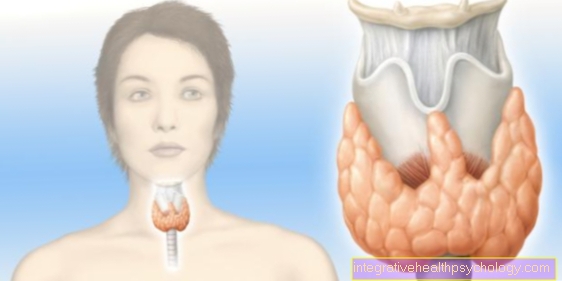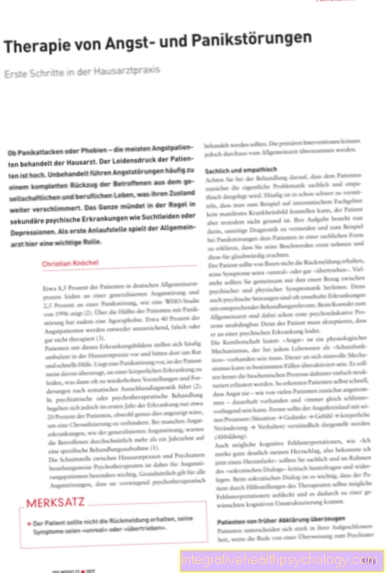Diarrheal diseases
definition
Diarrhea is a disease in which there is an increased frequency and liquefaction and thus a higher weight of the stool.
By definition, one speaks of diarrhea if more than three bowel movements per day, a stool amount of over 250 grams or a water content of more than three quarters.
Most diarrheal diseases are infectious and heal on their own after a few days. Pathogens can get into the gastrointestinal tract from the environment, for example, and cause disease there.
However, an imbalance in the natural colonization of the intestine caused by other factors (e.g. antibiotics) can also trigger diarrhea. In the treatment of diarrhea, it is important to drink enough water and to absorb the blood salts (electrolytes) that are lost through bowel movements in the case of diarrhea.

What diarrheal diseases are there?
In the case of diarrheal diseases, one can differentiate between different mechanisms by which the disease develops. So there is the great variety of infectious diarrhea, which includes both viral and bacterial diarrhea.
In bacterial diarrheal diseases, the symptoms can be triggered by various bacterial colonies such as campylobacter, salmonella, cholera, Yersinia and E. coli.
Bacterial, infectious diarrhea also includes diarrhea caused by an imbalance in the intestinal flora, for example when antibiotics are given. In this case, the pathogen Clostridium difficile typically spreads in the digestive tract and thus leads to diarrhea.
Read all about them here Side effects of antibiotics
Typical viral pathogens are the noro- and rotavirus, but other viruses such as the adenovirus can also lead to enteritis, i.e. inflammation of the digestive tract and thus to diarrhea.
Infectious diarrheal diseases are also rarely caused by parasites, fungi or worm diseases.
Do you want to know when a diarrheal disease is contagious? - Then read our article Which diarrhea is contagious?
Intolerance reactions constitute another group of diarrheal diseases. Certain substances from the intestine cannot be absorbed, instead they pull a lot of water into the intestine and thus trigger diarrhea.
This can happen, for example, in the case of lactose intolerance or gluten intolerance. Please note that there is a difference between a proven gluten intolerance (celiac disease) as an autoimmune disease with degradation of the small intestinal mucosa and a gluten sensitivity.
Damage to the intestines from surgery or medication and radiation can also cause diarrhea. There are also inflammatory bowel diseases such as Crohn's disease and ulcerative colitis, which also cause diarrhea.
Crohn's disease
Crohn's disease is a chronic inflammatory bowel disease that usually first shows up at the end of the small intestine.
It can later spread throughout the digestive tract from the mouth to the rectum.
Typically, the disease begins in young adulthood. Usually diarrhea and abdominal pain appear initially along with weight loss.
Specific risk factors for the development of Crohn's disease are not known, but the likelihood of an illness increases if other family members are affected.
Smoking can also be a risk factor for developing Crohn's disease.
As the disease progresses, more and more intestinal sections can be affected by the inflammatory disease. This can damage the intestinal wall, which can subsequently lead to the formation of fistulas (atypical connections between two hollow organs).
Also read our article about a Fistula in the intestine
In addition, the nutrients from the intestine can no longer be absorbed as well due to the chronic inflammation in Crohn's disease, which in addition to weight loss can also cause growth disorders in childhood and deficiency symptoms such as anemia.
In addition, other parts of the body such as joints, eyes, liver and skin can also be affected by inflammatory changes in Crohn's disease.
The blood and bowel movements can be examined diagnostically for characteristic signs.
Often an MRI and / or a colonoscopy is carried out in the course of this in order to be able to assess which bowel sections are affected. Since Crohn's disease is a chronic bowel disease, it usually has to be treated over the long term. For this purpose, drugs are used that have anti-inflammatory effects and regulate the body's immune response.
Read more about treating Crohn's disease below Medicines for Crohn's disease
Ulcerative colitis
Like Crohn's disease, ulcerative colitis initially manifests itself through abdominal pain, weight loss and diarrhea.
However, in ulcerative colitis, only the large intestine is affected by the chronic inflammation.
Genetic causes also play a role in ulcerative colitis, and drugs can also play a role in the development of the diarrheal disease.
In addition to the digestive tract, ulcerative colitis can affect other parts of the body, including the liver and bile ducts, as well as joints, skin and eyes.
The activity of inflammation markers in the blood and in stool plays an important role in diagnostics, and various antibodies can also be tested.
Imaging (often MRI) and a colonoscopy, during which tissue samples can be obtained, are also decisive for the diagnosis of ulcerative colitis.
The therapy consists initially of a drug treatment in which drugs are used that downregulate the response of the immune system. In contrast to Crohn's disease, ulcerative colitis can be cured by surgical treatment, but the entire colon must be removed for this.
Read more about the operation in our article Removing the large intestine - is life without it?
The use of surgical therapy must be decided on a case-by-case basis, since, depending on the situation of the person concerned, the quality of life can be improved by medication or by surgery.
Diarrheal diseases in Egypt
Diarrheal diseases are among the most common health restrictions that we have to accept when traveling to foreign countries and regions.
As with us, infectious diseases caused by bacteria and viruses often occur.
The fact that travelers are particularly often affected is because the body is not as well protected against foreign germs as it is against those pathogens that are present in our home regions.
In Egypt, too, diarrhea is most commonly caused by bacteria such as campylobacter, salmonella and E. coli, as well as viruses (noro- and rotavirus).
In addition, parasites such as entamoeba and girdiasis can lead to diarrhea.
Would you like to find out more about the parasites? - Then read our article Parasites in the intestines
Anyone who travels to Egypt must expect to be able to catch one of the pathogens in various places. So the flight to Egypt alone is linked to the encounter with many foreign people and thus also foreign pathogens.
In addition, diarrheal diseases can be triggered by germs from the local water and food. Anyone who is infected with diarrhea in Egypt should take hygienic measures such as frequent hand washing, hand disinfection if necessary, and avoiding direct contact with other people.
It is also important to drink enough to make up for the fluid loss. You only need to go to a medical center in severe cases. Most diarrheal diseases heal themselves after a few days.
However, anyone who comes back home with diarrhea after a trip to Egypt can also introduce themselves to the Tropical Institute.
Diarrheal diseases in Morocco
As in many other travel destinations, diarrhea is one of the most common complaints that you have to deal with on vacation or on business trips.
The unfamiliar germs in the unfamiliar environment make travelers particularly susceptible to diarrhea.
The most common sources of infection are water, food and toilets, which are visited on the trip.
To prevent diarrhea, hygienic measures such as regular hand washing and the boiling of tap water and food should be observed.
Fruit and salad in particular that are not cooked before consumption can be a source of infection for diarrhea in Morocco.
The most common pathogens that cause diarrhea in Morocco are bacteria and viruses. Mostly the same pathogen species are involved, but they occur in a slightly modified form, which is why our immune system is less well armed against these germs.
If a diarrheal disease breaks out, particular attention must be paid to drinking sufficient quantities. Tea is particularly suitable for this, as it is boiled water, and sugar can also be added to the tea, which also helps against the symptoms.
Many medicines from the first-aid kit such as Imodium® and charcoal tablets can also be used for treatment.
Do you want to learn more about treating diarrhea? - Then read our article Medication for diarrhea
Only in rare cases does parasites or worms cause diarrhea in Morocco.
Rotaviruses
Rotaviruses are one of the most common pathogens that can cause diarrhea.
Typically, children in particular are infected with the rotaviruses, as the infection takes place via smear infections and direct contact.
In addition to small children in their first years of life, older people (over 60 years of age) also belong to the population group at risk from rotaviruses.
The symptoms of diarrhea caused by rotaviruses consist of abdominal pain, particularly watery diarrhea, and possibly vomiting and fever.
The symptoms typically only occur for a few days (usually one to three days).
The danger of diarrhea caused by rotaviruses lies in the high loss of fluids, which must be compensated for by drinking enough water.
Blood salts (electrolytes) and sugar can also be lost through diarrhea and should be reabsorbed in larger quantities.
In general, those affected should not visit community facilities such as kindergartens, schools and old people's homes if they have diarrhea - especially if they have a proven rotavirus infection.
If the patient is admitted to hospital due to excessive fluid loss, the affected person must be isolated. To protect against rotavirus, vaccination is recommended for infants under six months of age.
Learn more about vaccinating against rotavirus at Vaccination against the rotavirus
Treatment of the disease consists of relieving symptoms with medication for fever, abdominal pain, and nausea, as well as providing sufficient fluids.
Noroviruses
The norovirus is also one of the typical viral pathogens causing diarrhea.
The viruses are transmitted via smear infections and contact infections and thus spread particularly quickly in community facilities.
Therefore, in addition to children (kindergarten and school), older people who live in old people's homes or who are in hospital for a certain period of time are particularly at risk of becoming infected with the norovirus.
In addition, these two age groups are hardest hit by the complications of diarrheal disease, as it is difficult for them to compensate for the dehydration caused by the large amount of fluid lost in the stool.
The norovirus is one of the highly infectious viral diseases; the infection usually takes place when an affected person has symptoms and passes the virus on.
The symptoms consist of nausea and vomiting along with severe diarrhea. Abdominal pain or cramps can also occur.
The loss of fluid also leads to headaches.
Fever, on the other hand, is rather a rare symptom of norovirus infection.
With norovirus, symptoms usually go away within one to two days. If a norovirus infection is suspected, the pathogen can be detected in stool samples.
Especially in severe cases, the fluid balance of the person concerned should be monitored as well as the blood salts (electrolytes). Therapy consists of drinking a sufficient amount of water. If this cannot be achieved, additional fluid may have to be given through the vein.
The electrolytes should also be balanced with sugared teas and salty broth. If necessary, this compensation can also take place via an infusion into the vein.
Would you like to know whether you have contracted the norovirus? - Then read our article Symptoms of Norovirus Infection
Campylobacter
Campylobacter is a type of bacteria that is one of the most common diarrheal pathogens in Germany.
The germs also occur naturally in humans, but if there is an imbalance in the bacteria in the intestine, they can also lead to diarrhea.
Typically, Campylobacter is taken in through food. The contaminated food can be raw meat (minced meat or poultry), milk and drinking water can also be the source of the infection.
If a person suffers from Campylobacter enteritis (= inflammation of the intestine caused by Campylobacter), the infection can also take place directly from person to person.
Bacteria can also be transmitted by water, so you can get infected in polluted water, for example while bathing.
In the case of diarrhea caused by Campylobacter, general symptoms of infection such as fever, fatigue and headache occur initially. Later there are severe cramp-like abdominal pain and sometimes bloody diarrhea.
Read more about bloody diarrhea below Blood in the stool with diarrhea
The disease often lasts for about a week, after which the symptoms disappear again. However, affected people are contagious for up to four weeks as they continue to excrete the bacteria with their stool.
A detailed diagnosis is not made for every diarrheal illness, but if you want to prove the infection with Campylobacter, a stool sample can be carried out.
The treatment of Campylobacter infection should usually be purely symptomatic. A sufficient amount of water to drink or the administration of fluid via the vein and, if necessary, the addition of electrolytes is usually suitable for the treatment.
Would you like to know what simple means can be used to fight diarrhea? - Then read our article Home remedies to treat diarrhea
Salmonella
Salmonella also belong to the group of bacterial pathogens that primarily cause inflammation of the gastrointestinal tract and thus lead to diarrhea.
In the case of Salmonella, too, the infection takes place via contaminated food such as eggs, poultry and milk. Sufficient heating of the food can kill the bacteria.
However, Salmonella have a special feature: they cannot be killed by the cold and therefore also by freezing the food alone.
Do you have diarrhea and want to know what else to eat? - Then read our article Diet for diarrhea
However, a small amount of salmonella does not always lead to infection; a larger number of bacteria is often necessary to cause diarrhea caused by salmonella.
Typically, flu-like symptoms and diarrhea occur in the context of salmonellosis (disease with salmonella). The diarrhea is usually watery, and occasionally it can look bloody.
Read more about bloody diarrhea below Blood in the stool with diarrhea
As with most diarrheal diseases, therapy consists of an adequate supply of fluids and electrolytes. In severe cases, antibiotics such as fluoroquinolones and cephalosporins can be given.
EHEC
EHEC is an abbreviation for a sub-genus of the bacterial species Escherichia coli (E. coli for short) that occurs naturally in the intestine.
EHEC stands for enterohaemorrhagic E. coli. These bacteria are pathogens that usually cause bloody diarrhea (hence the name hemorrhagic).
Read more about bloody diarrhea below Blood in the stool with diarrhea
The EHEC bacteria typically produce a certain intestinal toxin: the so-called Shiga-like toxin. If it releases this toxic substance, diarrhea with watery and bloody stools occurs.
The E. coli infection can basically be treated with antibiotics, but in the case of EHEC infection this initially leads to a worsening of the symptoms. The antibiotic kills the bacteria, but at the same time a large amount of Shiga-like toxin is released from the dead bacterial cells, which can significantly worsen the diarrhea.
A complication of diarrheal disease with EHEC is HUS (hemolytic uremic syndrome). The intestinal toxin gets into the bloodstream and then also damages the kidney corpuscles, so that affected people also pass bloodied urine.
EPEC
EPEC is also a name for a subspecies of E. coli bacteria. The abbreviation stands for enteropathogenic Escherichia coli. Although many E. coli bacteria are found in our intestines in a healthy state, infection with EPEC can lead to diarrhea.
This is usually associated with several liquid stools as well as abdominal pain and possibly nausea and vomiting.
Yersinia
Yersinia enterocolitica and Yersinia pseudotuberculosis are a species of bacteria that can be transmitted from animals to humans and thereby cause diarrheal diseases.
The transmission mostly takes place via foods such as dairy products and raw or undercooked meat.
Classically, yersiniosis results in pain in the right lower abdomen, which means that yersiniosis (disease with Yersinias) can often be confused with appendicitis.
In contrast to many other bacterial diarrheal diseases, an infection with Yersinia leads to long-lasting diarrhea with abdominal pain and sometimes nausea and vomiting over several weeks.
In severe cases, antibiotic therapy can be used, otherwise a sufficient amount of water to drink and light food are usually sufficient to treat yersiniosis.
In people with certain genetic requirements (HLA-B27 patients), an infection with Yersinia can also lead to skin and joint inflammation.
Another bacterial species of the Yersinia (Yersinia pestis) was also responsible for the plague epidemics. However, these are no longer available in our latitudes.
Do you want to learn more about Yersinia pestis? - Then read our article on that bubonic plague




.jpg)
























